Most U.S. military service members are aware of the Japanese samurai and know their primary weapon was the katana, or samurai sword, but few are privy to the glory of the tanto blade.
I’ve been a fan of Japanese history and Eastern philosophy for many years, so when my wife and I visited Tokyo years ago, I made sure to take her by Sengaku-ji, which is a Zen Buddhist temple near the Shinagawa Station where Lord Asano Naganori and the 47 Ronin are buried. If you’re not familiar with the story, it’s a revenge classic and well worth your time. For the encore, I took her to the Japanese Sword Museum near the Ryogoku Station. It’s a small museum dedicated to preserving the art of Japanese sword making. There you can see samurai swords from the 12th to the 19th centuries, more katanas than you can swing a dead cat at, and a fair amount of wakizashi, or short swords. The museum has a few tachi, which were saber-like long swords that differed in purpose from the push and pull katanas. More importantly, they also have tantos, which are more dagger than sword as their primary purpose was for stabbing opponents in extremely close quarters.
The funny thing about Japanese tantos is that they look nothing like the tanto knives you see on the market today with their triangular tips. The tanto of the samurai had a straight back tip design with a single edge and curved blade, while modern tantos are an American bastardization of this elegant tradition with their obnoxiously triangular design. Legend has it that the knife manufacturer Cold Steel is responsible for introducing the modern variant to the market in the 1970s, and like most stylistic decisions from the ‘70s, I wish it had gone the way of bell-bottoms, Naugahyde, and lava lamps. While I love the graceful, traditional Japanese tantos, I’m not a fan of the modern American ones.
So, what’s a tanto blade for? They’re built for one thing: puncturing. Like the Japanese tanto, modern tanto blades have strong tips which make them excel at piercing. Unfortunately for the American tanto, it delivers subpar performance in almost every other use, from slicing to dicing, as they don’t have a curved belly like a clip or drop point blade. They’re also more difficult to carve with, suck as hunting and skinning knives, and are awkward in the kitchen for food preparation since the blade does not support a good rocking motion. The lack of a belly to the blade also makes it tougher to cut through rope, and they tend to be harder to sharpen due to the 150-degree angular transition between the two separate sections of the blade edge.
With all of that said, I’ll tell you what I think about the CRKT M16-14SFG and why maybe, just maybe, you should consider leaving this particular tanto blade on the shelf.
Blade length: 4 in
Weight: 5.9 oz
Material: 8Cr14MoV stainless steel (blade), G10 (handle)
Unboxing
The CRKT M16-14SFG came in almost the exact same green recycled cardboard box as the CRKT M21-04G I reviewed earlier. What I absolutely loved about CRKT’s packaging decision was that it minimized single-use plastics. Bravo! Now just please ditch the small plastic baggie too, and you’ll have reached near perfection.
Humorously, the knife came with an advertising pamphlet advising users on how to avoid being asked to work the weekend by your boss. Their recommendations were: 1) tell your boss you have a family emergency, 2) fake an illness, and 3) cut a hole in the ceiling with a K.I.S.S. knife and climb out.
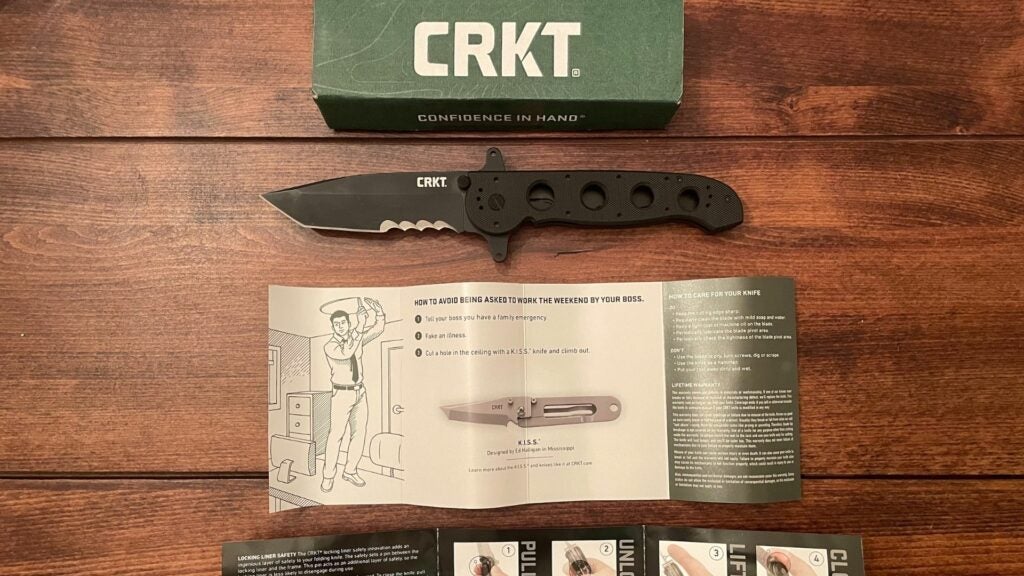
The box also had a secondary pamphlet instructing users on how to manipulate the M16-14SFG’s locking liner and automated liner safeties, and users new to CRKT should read it since closing the knife is a not-so-intuitive two-step process that’s easily mastered. Like the M21-04G, the M16-14SFG had a Carson flipper on the bottom to open the blade. Unlike the M21-04G, it had two Carson flippers — an additional one at the top that would prove problematic during testing. The purpose of the dual Carson flippers, according to CRKT, is to provide a “true hilt” to the knife, ostensibly to protect one’s hand when knife fighting.
One note about the naming convention: It’s pretty obvious CRKT was trying to achieve a very “operator” vibe with this blade. Everything from the tactical black color scheme to the non-reflective titanium nitride blade coating seemed like marketing bait for operator wannabes, military cosplay nerds, and incels. When I went to the CRKT website, I discovered the M16-14SFG was indeed part of their Special Forces G10 line that “share a unique design offering a combination of Carson M16 Series features requested by military procurement specialists.” Anytime anything is marketed as “Special Forces,” I get suspicious, and anytime a manufacturer brags about being milspec, I think: lowest bidder.
How we tested the CRKT M16-14SFG
I committed to carrying the CRKT M16-14SFG with me everywhere every day for a week and using it exclusively for all of my cutting needs. It would be my everyday carry, and I resolved to become one with the knife. Unfortunately, the first thing the M16-14SFG did was inadvertently open while clipped tip down and blade forward to my right pocket and cut my inner wrist. I’m not exactly sure if the top Carson flipper caught on my seatbelt as I was exiting my truck or if it hung up on my keys as I pulled them out of my pocket. But as I was shopping for groceries, I dropped my right hand, moved up, and felt a slight slice on my inner wrist. I looked down, and there was about 1/16 of an inch of the CRKT M16-14SFG’s tanto tip poking through my pocket. Being ambushed by a new “Special Forces” pocket knife isn’t a great way to begin.
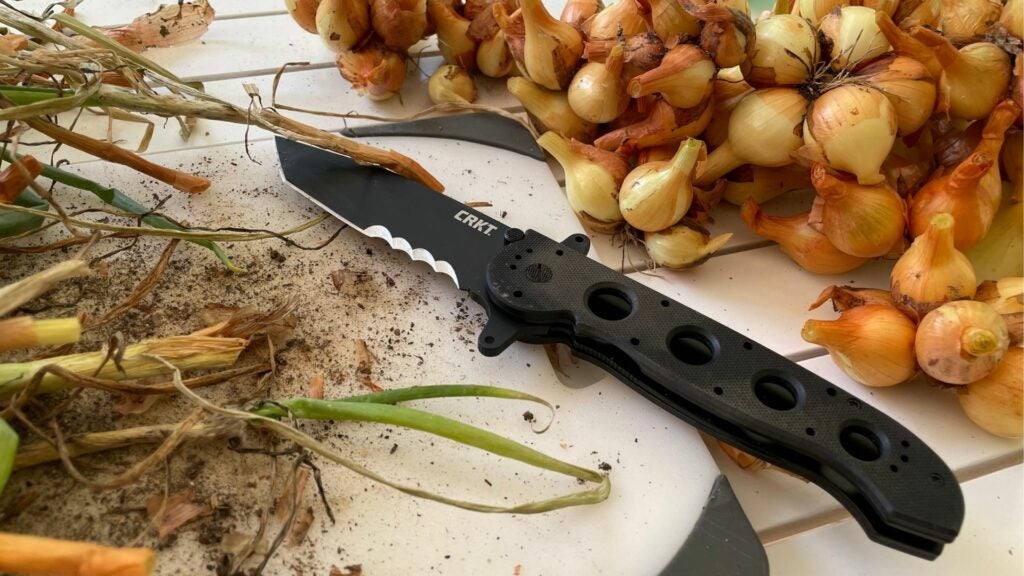
Test 1: Cut harvested produce. When I returned home, I had to clean up some harvested onions and shallots I was curing on the back porch. I used the M16-14SFG’s 1-1/16th-inch tanto tip to cleanly slice through the tough, dried, fibrous necks with a push cut. I couldn’t use the 1.5 inches of plain blade below the tip as the bottom Carson flipper prevented that part of the knife from slicing along the cutting board. In fact, when the blade is laid along a flat surface, only the apex of the 150-degree blade angle touches the surface. This design makes it rather useless for slicing or dicing.
While I wasn’t impressed with the blade’s food preparation utility or versatility, I was impressed with the blade’s out-of-the-box sharpness. CRKT uses the same 1.4116 stainless steel in the M16-14SFG as the M21-04G, which is similar to lower mid-range 420HC. Essentially, this means it won’t keep an edge as long as higher-quality steel, but it is easier to sharpen and is one of the most corrosion-resistant steels available. For more on knife steel, here’s a good primer.
Additionally, the knife has the same ergonomics of the M21-04G, which I found was comfortable in my big hands. The scales along the handle are made from quality G10 fiberglass laminate and have a textured basket weave pattern that provides sufficient grip.
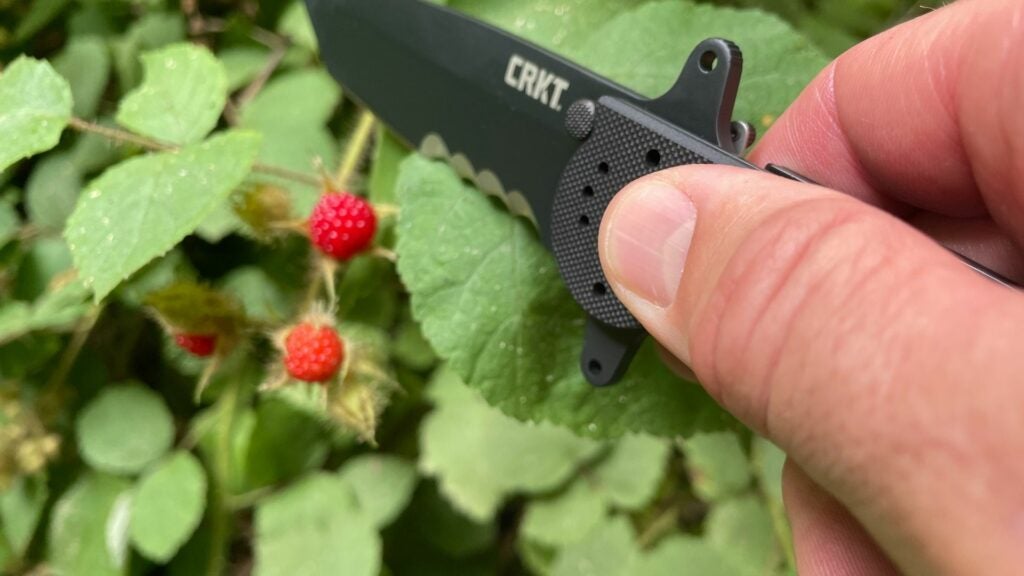
Test 2: Cut rope. The cucumber plants in my garden are about seven feet long now and I have them growing up a bamboo trellis. I needed to provide them some additional support, so I used the M16-14SFG to cut lengths of 3/8ths-inch jute rope to use for reinforcing lashings. The blade did so with ease due to the Veff serrations on the first 1.5 inches of the blade. Again, the factory did a great job sharpening this knife prior to distribution.
Test 3: Prepare dinner. This task proved to be fairly frustrating as the Americanized tanto isn’t designed to be a kitchen knife. The funny thing is that the spear point M16-04G was way easier to use in cutting vegetables and meat due to the knife’s plain edge and curved belly. The tanto would only cut partially through vegetables like carrots and zucchini, and then I’d have to separate the remainder with a turn of the wrist. Sub-optimal.
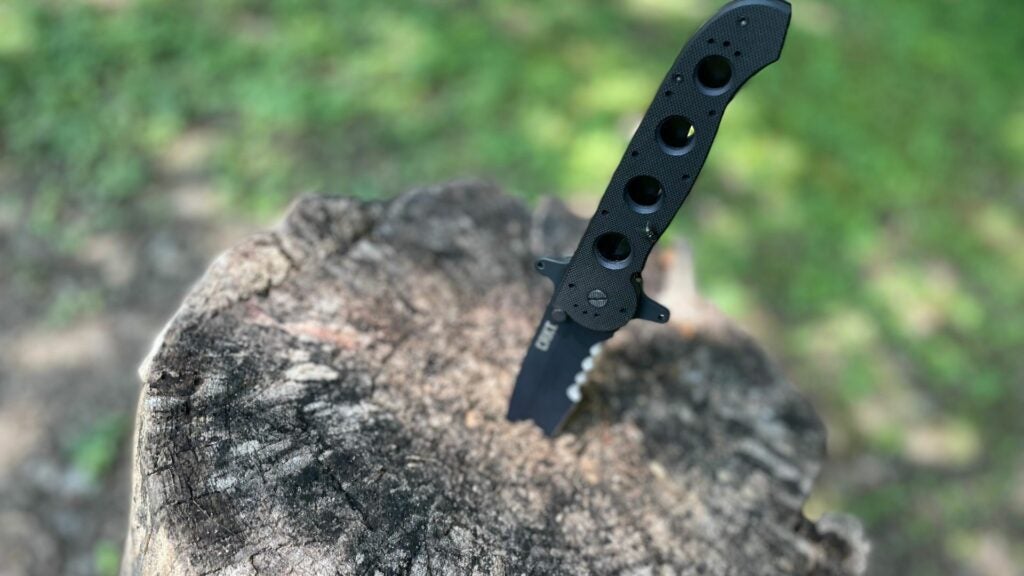
Test 4: Stab something. I found an old hardcover calculus textbook in my basement, placed it on the ground, and, with the M16-14SFG in a reverse edge out grip, stabbed down through the cover. The tanto tip reached down to page 355, and while I don’t know what that means scientifically, the blade punctured the cover so effortlessly that I wouldn’t want to be on the receiving end of it. I haven’t worked on any knife fighting techniques since Marine Corps Martial Arts Green Belt days — which was pretty hilarious — so I consider myself to be the furthest thing from an expert in this area. I did find a kitschy book on Amazon called Tanto: Japanese Knives and Knife Fighting if you want to dive down that rabbit hole.
Test 5: Pry and scrape something. A few tanto aficionados online were lauding the American tanto’s ability to pry and scrape, so I applied it to those purposes. It was handy in scraping off old stickers from the back window of my truck and popped open a gallon paint can. I don’t recommend using knives for prying, but figured what the heck since multiple knife experts online were lauding how strong the triangularized tip design is. It didn’t break or deform.
Test 6: Opening cardboard boxes. As a gear reviewer, I frequently get shipping boxes sent to my home. The sharp tanto blade cut through packing tape with ease. It also easily punctured double-layer cardboard boxes that I stabbed on the way to the recycle bin.
What we like about the CRKT M16-14SFG
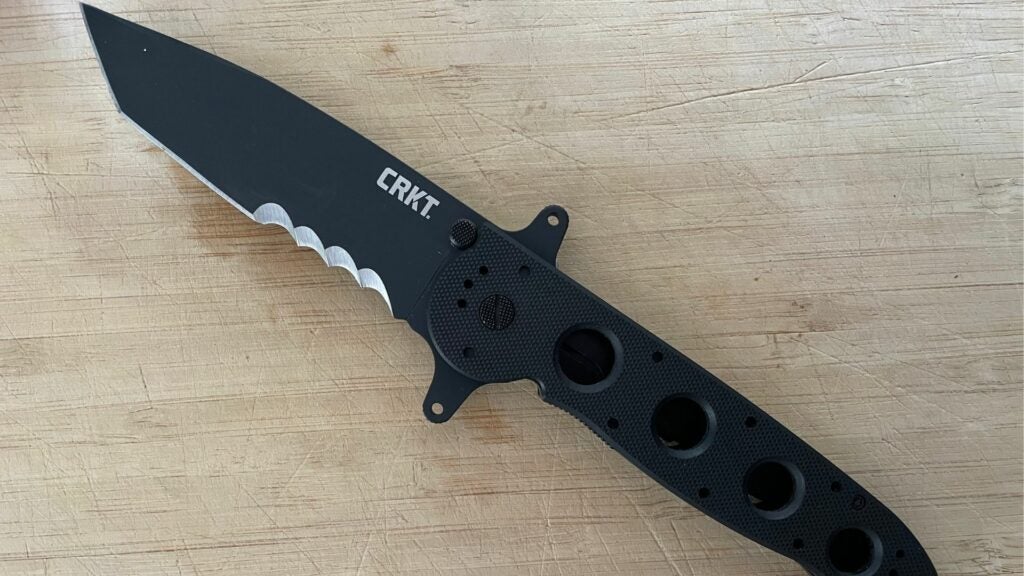
While I was surprised I liked the M21-04G, I had a more difficult time appreciating the M16-14SFG. I found the blade to be very sharp out of the box and the knife deploys with the Carson flippers quickly and sets with a satisfying thunk. I like the G10 scales, the ambidextrous pocket clip, the ergonomics, the open-back handle design for ease of cleaning, and the locking liner and automated liner safety.
What we don’t like about the CRKT M16-14SFG
First, I’m not a huge American tanto blade fan, so take that with a grain of salt. Second, the double Carson flipper design can cause the knife to deploy in one’s pocket unexpectedly, and that’s a bad thing. It hung up on something, deployed the blade, poked a hole through my pocket, and cut my wrist. Not cool.
Second, I also don’t like that I was able to hard-shake the blade open with a downward whip of my hand. I’m unable to do this with any of my Spyderco knives.
Third, it’s a heavy blade. The M16SFG weighs in at a beefy 167 grams (5.9 ounces). That’s more than I want to carry around every day.
Fourth, the 150-degree angle on the tanto blade combined with the lower Carson flipper doesn’t allow the knife to fully come in contact with a flat cutting surface.
Fifth, I’m not a fan of partially serrated blades. They’re harder to sharpen, require a special sharpener, and I don’t think the serration is worth it. The tanto blade design itself is harder to sharpen than a plain blade, so the angular blade plus the serration is a double whammy for me.
Verdict
The CRKT M16-14SFG is a hard pass for me. I know modern American tanto freaks will have a conniption and probably an aneurism when they read this, but I just didn’t vibe with this knife. Although I prefer lighter, high-quality knives like the Spyderco Para Military 2, I did appreciate the CRKT M16-04G, which has the exact same handle as the M16-14SFG with a better-designed spear point blade and only a lower Carson flipper. Between the two, I’d go with the M16-04G — unless your job is stabbing people, which probably means you’re with a Tier 1 team or a complete psychopath.
Saved rounds
Once the blade unintentionally deployed in my pocket, I became curious as to whether I could hard-shake the blade open. I was able to do so with a flick of my wrist. I tested this against my Spyderco Para Military 2 and was unable to replicate the opening. It is my opinion that this makes the knife less safe than models that can’t be hard-shaken open.
FAQs about the CRKT M16-14SFG
More questions? Here’s Task & Purpose’s additional brief.
Q. How much does the M16-14SFG cost?
A. The CRKT M16-14SFG’s MSRP is $99.99 but I found it on Amazon for $73.95.
Q. Joe, why do you hate the American tanto design so much?
A. Although I’m far from a traditionalist, some traditional designs have achieved perfection and should not be messed with. The Japanese tanto was improved upon by generations of sword makers over more than eight millenia. I just find the modern American tanto to be goofy.
Q. Are the Veff serrations easier to sharpen than three point serrations?
A. I didn’t sharpen them during this evaluation, but CRKT claims they are. For more, check this out.
Q. Can I carry this knife tip down?
A. Although the handle is pre-drilled for ambidextrous tip-up or tip-down carry, the web page for the M16-14SFG states clearly that “these knives are not designed for tip-up in-pocket carry.” It unintentionally opened on me in a tip-down blade forward position, poked a hole in my pocket and cut my wrist, so make of that what you will.
We’re here to be expert operators in everything How-To related. Use us, compliment us, tell us we’ve gone full FUBAR. Comment below and let’s talk! You can also shout at us on Twitter or Instagram.
Joe Plenzler is a Marine Corps veteran who served from 1995 to 2015. He is a backcountry expert, long-distance backpacker, rock climber, kayaker, cyclist, wannabe mountaineer, and the world’s OK-est guitar player. He supports his outdoor addiction by working as a human communication consultant, teaching at the College of Southern Maryland, and helping start-up companies with their public relations and marketing efforts.
Task & Purpose and its partners may earn a commission if you purchase a product through one of our links. Learn more about our product review process.
